
Black-figure pottery painting, also known as the black-figure style or black-figure ceramic, is one of the styles of painting on antique Greek vases. It was especially common between the 7th and 5th centuries BCE, although there are specimens dating as late as the 2nd century BCE. Stylistically it can be distinguished from the preceding orientalizing period and the subsequent red-figure pottery style.
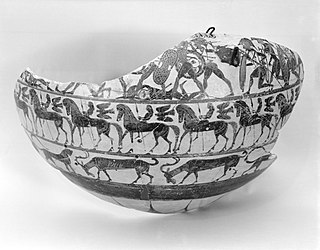
The Cavalcade Painter is the conventional name for an ancient Greek vase painter who produced Corinthian black-figure vases. He was active during the Middle Corinthian period, around 580 BC.

The Arkesilas Cup is a kylix by the Laconian vase painter known as the Arkesilas Painter, whose name vase it is. It depicts, and is thus named after, Arkesilaos II, king of Kyrene and is dated to about 565–560 BC.
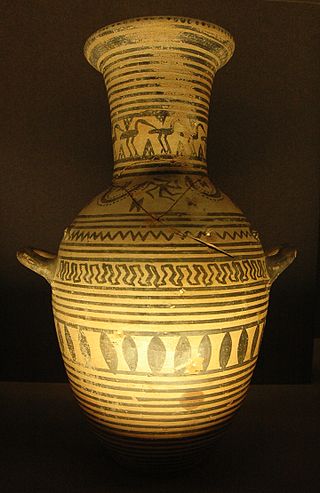
Boeotian vase painting was a regional style of ancient Greek vase painting. Since the Geometric period, and up to the 4th century BC, the region of Boeotia produced vases with ornamental and figural painted decoration, usually of lesser quality than the vase paintings from other areas.

The term Kabiria Group describes a type of Boeotian vases decorated in the black-figure technique. The term can also be used describe the artists producing vases of the type.
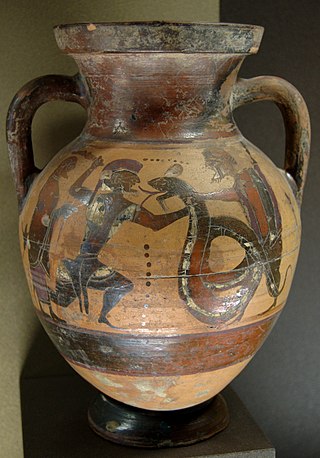
Euboean vase painting was a regional style of ancient Greek vase painting, prevalent on the island of Euboea.

East Greek vase painting was a regional style of ancient Greek vase painting, produced by the eastern Greeks. In spite of the region's wealth, the pottery was rather unremarkable in comparison to other areas. The clay is red-brown to pink and often contains mica inclusions. Many regional sub-styles of East Greek pottery existed.
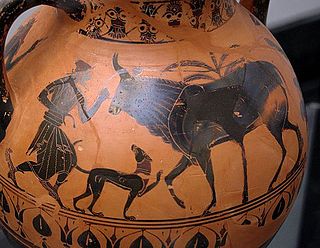
The Northampton Group was a stylistic group of ancient Greek amphorae in the black-figure style.

Rhodian vase painting was a regional style of East Greek vase painting, based on the island of Rhodes.

The Pontic Group is a sub-style of Etruscan black-figure vase painting.

Etruscan vase painting was produced from the 7th through the 4th centuries BC, and is a major element in Etruscan art. It was strongly influenced by Greek vase painting, and followed the main trends in style over the period. Besides being producers in their own right, the Etruscans were the main export market for Greek pottery outside Greece, and some Greek painters probably moved to Etruria, where richly decorated vases were a standard element of grave inventories.

Argive vase painting was a regional style of Greek Geometric vase painting from the city of Argos.
Cycladic vase painting was a regional style of Greek vase painting, produced in the Cycladic islands.

Samian vase painting was a regional style of ancient Greek vase painting; it formed part of East Greek vase painting.

Sicilian vase painting was a regional style of South Italian red-figure vase painting fabricated in Magna Graecia. It was one of five South Italian regional styles. The vase painting of Sicily was especially closely connected with the Lucanian and Paestan styles.

Campanian vase painting is one of the five regional styles of South Italian red-figure vase painting fabricated in Magna Graecia. It forms a close stylistic community with Apulian vase painting.

Klazomenian vase painting was a regional style of ancient Greek vase painting, belonging to the East Greek representations of that form of art.
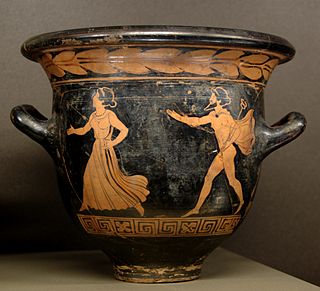
Lucanian vase painting was substyle of South Italian red-figure vase painting fabricated in Magna Graecia, produced in Lucania between 450 and 325 BC. It was the oldest South Italian regional style. Together with Sicilian and Paestan vase painting, it formed a close stylistic community.

Paestan vase painting was a style of vase painting associated with Paestum, a Campanian city in Italy founded by Greek colonists of Magna Graecia. Paestan vase painting is one of five regional styles of South Italian red-figure vase painting.

The Dionysus Cup is the modern name for one of the best known works of ancient Greek vase painting, a kylix dating to 540–530 BC. It is one of the masterpieces of the Attic black-figure potter Exekias and one of the most significant works in the Staatliche Antikensammlungen in Munich.



















